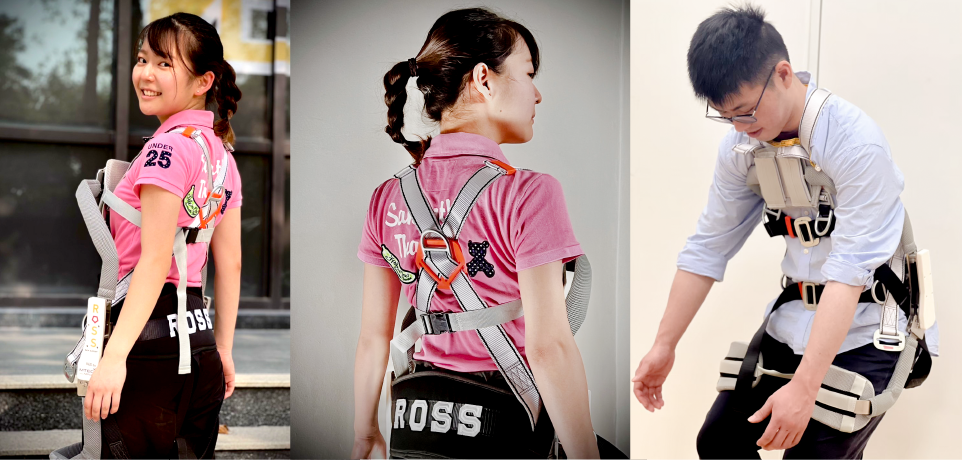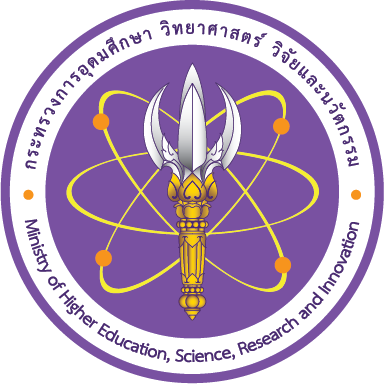‘Ross (รอส) บอดีสูทพยุงหลัง’ ป้องกันการบาดเจ็บจากการยกผู้ป่วย ผู้สูงอายุ และสิ่งของน้ำหนักมาก (“Ross” Back-Support Exoskeleton for Injury Risk Reduction in Patient-handling and Heavy-lifting Tasks)

ปัญหาการบาดเจ็บที่พบได้ส่วนใหญ่ในบุคลากรทางการแพทย์ ผู้ดูแลผู้สูงอายุ หรือผู้ที่ต้องยกของที่มีน้ำหนักมากเป็นประจำ คือ ‘อาการปวดหลังส่วนล่าง’ ซึ่งหากปล่อยให้มีอาการบาดเจ็บเรื้อรังอาจส่งผลร้ายแรงถึงขั้นกระทบต่อการดำเนินชีวิตหรือต้องยุติการทำงานที่ใช้แรงจากกล้ามเนื้อหลังได้ สำนักงานพัฒนาวิทยาศาสตร์และเทคโนโลยีแห่งชาติ (สวทช.) โดยศูนย์เทคโนโลยีโลหะและวัสดุแห่งชาติ (เอ็มเทค) ร่วมกับพันธมิตร ออกแบบและพัฒนา ‘Ross (รอส) ชุดบอดีสูทพยุงหลัง (Motion-assist exosuit) รุ่น Back support เพื่อป้องกันและลดความเสี่ยงต่อการบาดเจ็บให้คนไทย
Lower back pain (LBP) is a prevalent musculoskeletal disorder associated with manual handling tasks in healthcare personnel, caregivers, and manual labor workers. Chronic injury to the back can affect quality of life and reduce workers’ ability to effectively perform their jobs. Researchers at the National Metal and Materials Technology Center (MTEC), under the National Science and Technology Development Agency (NSTDA), along with technical partners, have designed and developed a motion-assist exosuit for back support named “Ross”. The main function of “Ross” is to prevent back injuries for those who are at risk in their workplace.

ดร.ศราวุธ เลิศพลังสันติ ผู้อำนวยการกลุ่มวิจัยการออกแบบเชิงวิศวกรรมและการคำนวณ เอ็มเทค สวทช. เล่าว่า มีคนวัยทำงานจำนวนมากที่มีอาการบาดเจ็บเรื้อรังที่บริเวณกระดูกสันหลังส่วนล่าง บริเวณ L5 แล S1 หรือบริเวณหมอนรองกระดูกในระดับที่รักษาให้หายขาดได้ยาก เช่น บุคลากรทางการแพทย์หรือผู้ดูแลที่ต้องยกหรือพลิกตัวผู้ป่วยและผู้สูงอายุเป็นประจำ ผู้ทำงานด้านการขนส่งที่ต้องยกสินค้าที่มีน้ำหนักมากโดยไม่สามารถใช้เครื่องทุ่นแรงช่วยได้ ซึ่งอาการเหล่านี้มักเกิดจาก ‘การยกผิดท่าหรือการใช้งานร่างกายอย่างหนักเป็นประจำ’ ผลเสียที่ตามมาคือนอกจากคนวัยทำงานเหล่านั้นจะต้องเผชิญความเจ็บปวดในการใช้ชีวิตประจำวันแล้ว อาจต้องย้ายตำแหน่งหรือเปลี่ยนอาชีพเพื่อหลีกเลี่ยงการทำให้ร่างกายบาดเจ็บเพิ่มเติม หากเป็นลูกหลานที่ต้องดูแลผู้สูงอายุภายในบ้านก็อาจต้องว่าจ้างผู้ดูแลจากภายนอกมาให้การช่วยเหลือแทนด้วย
According to Dr.-Ing. Sarawut Lerspalungsanti, director of the Engineering Design and Computation (EDC) research group, “Chronic injuries to the lower back, especially at the L5-S1 lumbosacral joint, is very common in the workforce and is difficult to cure. This type of injury is frequently found in nurses, caregivers, and those whose jobs often require lifting of heavy objects. The injuries can be caused by several ergonomic risk factors, e.g., high number of repetitions, poor posture, and heavy loads. The result is not only a decline in the individual’s quality-of-life due to chronic pain, but also reduced workplace productivity, which could further result in social and financial burdens.”

จากปัญหาดังกล่าวทีมวิจัยได้พัฒนา ‘Ross (รอส) ชุดบอดีสูทพยุงหลัง (Motion-assist exosuit) รุ่น Back support’ เพื่อช่วยดูแลกล้ามเนื้อหลังของผู้ใช้งานผ่านการควบคุมร่างกายให้ออกแรงยกด้วยท่าทางที่เหมาะสม และช่วยทุ่นแรงกล้ามเนื้อจุดที่สำคัญ
ดร.ศราวุธ อธิบายถึงกลไกการทำงานของ Ross ว่า เมื่อผู้ใช้งานสวมใส่ Ross และปรับชุดให้กระชับบริเวณกล้ามเนื้อ 4 จุด หน้าอก หลัง เอว และต้นขา ชุดจะช่วยควบคุมให้ผู้ใช้งานออกแรงยกด้วยท่าทางที่เหมาะสมหรือท่า ‘สควอต (Squat)’ เป็นการย่อเข่าลง ยืดหลังตรง เกร็งหน้าท้อง แล้วใช้แรงจากแขนและขาในการยกสิ่งของขึ้น ซึ่งชุดจะควบคุมไม่ให้ผู้ใช้งานยกสิ่งของด้วยท่าก้มโค้งแล้วใช้แรงจากหลังในการยก เพราะเป็นท่าที่เสี่ยงต่อการทำให้กล้ามเนื้อหลังบาดเจ็บ
“เมื่อผู้ใช้งานยกของด้วยท่าสควอต ร่างกายจะพับชุดที่มีโครงสร้างภายในคล้ายสปริงตัว ‘V’ ซึ่งมีจุดหมุนอยู่บริเวณเอวและปลาย 2 ด้านอยู่บริเวณหน้าอกและต้นขาลง เกิดเป็นการสะสมพลังงานเพื่อผลักให้ร่างกายกลับสู่ท่ายืนตรง เป็นการทุ่นแรงกล้ามเนื้อส่วนต่างๆ และช่วยลดความเสี่ยงในการบาดเจ็บให้แก่ผู้สวมใส่ ทั้งนี้ชุดผ่านการออกแบบให้สวมใส่ได้สะดวกรวดเร็ว ผู้ใช้งานจึงไม่จำเป็นต้องสวมชุดล่วงหน้าเพื่อเตรียมพร้อมปฏิบัติงาน หากเกิดเหตุจำเป็นต้องยกสิ่งที่มีน้ำหนักมากเมื่อไหร่ก็หยิบชุดมาสวมใส่อย่างถูกต้อง (กระชับกล้ามเนื้อส่วนที่สำคัญทุกส่วน) ได้ภายในหลักวินาที”
To address this problem, the Well-living Design Team has designed “Ross” to lower the risk of back injury by adjusting the users’ lifting posture and reducing the compression load on the lumbosacral joint.
“Ross” can be adjusted the user’s body size at four different parts of the body: chest, back, waist, and upper legs, to ensure a comfortable fit and proper function of the exosuit. “Ross” assists the user in performing squat-lifting tasks in an ergonomically correct posture: with bent knees, straight back, and tensed core muscles, using the leg and arm muscles to lift. The exosuit effectively prevents users from bending their back while lifting, thereby utilizing their back muscles as primary task performers, an action that often leads to back injuries.
When users bend down to perform a squat-lift, their body pivots “Ross” around a pivot joint located at the waist. The two pivot arms are the parts of “Ross” extending from the waist to chest and waist to quadriceps. This action is akin to the compression of a spring, creating stored energy, which is later released during the extension of the body to lift the object. By this mechanism, “Ross” lowers the compression force on the L5-S1 joint and reduces risk of injury to the back muscles.
Importantly, “Ross” is designed for easy donning and doffing, allowing users to quickly utilize it when needed in a matter of seconds. With both function and affordability in mind, “Ross” is manufactured with domestic materials, reducing its cost and concern for material/parts supply continuity.


ชุด Ross ผ่านการออกแบบโดยคำนึงถึงต้นทุนที่เหมาะสม เพื่อจำหน่ายใน ‘ราคาที่จับต้องได้’ ช่วยให้คนไทยเข้าถึงการใช้งานได้จริง ที่สำคัญชุด Ross ผลิตจากวัสดุภายในประเทศทั้งหมด จึงลดการนำเข้าและลดความเสี่ยงในการขาดแคลนวัสดุจากเหตุวิกฤตต่าง ๆ ได้เป็นอย่างดี
ดร.ศราวุธ เล่าถึงความท้าทายในการพัฒนาผลงานว่า สิ่งที่ทีมให้ความสำคัญอย่างมากตลอดการทำวิจัยคือการควบคุมการผลิตให้เกิดความสมดุลระหว่างคุณภาพของชุดกับต้นทุนการผลิต เพราะปัจจุบันชุดที่จำหน่ายทั่วไปมีราคาค่อนข้างสูงในระดับที่ผู้ประกอบการไทยส่วนใหญ่ไม่สามารถจัดเตรียมชุดเพื่อช่วยลดความเสี่ยงในการบาดเจ็บให้แก่บุคลากรของตนได้ และแน่นอนว่ายังมีราคาสูงเกินกว่าที่ลูกหลานในอีกหลายครอบครัวจะซื้อติดบ้านไว้เพื่อใช้ในการดูแลผู้สูงอายุ ดังนั้น Ross จึงผ่านการออกแบบให้ชุดทำงานได้มีมีประสิทธิภาพสูง แข็งแรงทนทาน แต่ยังคงน้ำหนักของชุดไว้ที่ประมาณ 3-4 กิโลกรัม เพื่อลดต้นทุนในการผลิต ทำให้ราคาของผลิตภัณฑ์ต้นแบบถูกกว่าราคาของผลิตภัณฑ์จากต่างประเทศ 3-4 เท่า และคาดว่าเมื่อขยายการผลิตสู่ระดับอุตสาหกรรมจะลดต้นทุนลงได้อีก ปัจจุบันทีมวิจัยพร้อมถ่ายทอดเทคโนโลยีการผลิต Ross แก่ผู้ประกอบการแล้ว
“สำหรับการวิจัยในเฟสต่อไป ทีมวิจัยได้รับทุนสนับสนุนจากหน่วยบริหารและจัดการทุนด้านการเพิ่มความสามารถในการแข่งขันของประเทศ (บพข.) ในการวิจัยต่อเนื่องเรื่องการนำระบบปัญญาประดิษฐ์ (AI) มาหนุนวิเคราะห์การเคลื่อนไหวร่างกายของผู้สวมใส่ เพื่อนำไปสู่การออกแบบชุดที่ดูแลร่างกายของผู้ใช้งานได้มากยิ่งขึ้น” ดร.ศราวุธ กล่าวทิ้งท้าย
Dr. Lerspalungsanti stated that one of the product development challenges was preserving a balance between the quality and function of the product and the materials and production costs. Equivalent products on the market tend to be costly, deterring potential customers in Thailand, whether from the healthcare or manufacturing sectors, or individual caregivers looking to purchase for personal use. “Ross” has been proven to be mechanically robust and effective in reducing back injuries while weighing 3-4 kilograms. This design enables a three- to four-fold reduction in price, compared to similar foreign products. We expect the price to decrease even further with our forthcoming plans for commercial-scale production. Currently, “Ross” is in the process of technology transfer to a Thai manufacturer.

Ross เป็นหนึ่งในนวัตกรรมเพื่อ ‘ผู้สูงอายุ’ และ ‘ผู้ดูแล’ ที่นักวิจัยเอ็มเทค สวทช. วิจัยและพัฒนาขึ้นเพื่อขานรับการเข้าสู่สังสังคมผู้สูงวัยอย่างสมบูรณ์ของไทย ซึ่งเอ็มเทคพร้อมถ่ายทอดเทคโนโลยีทั้งสามแล้วในปีนี้ ผู้ที่สนใจรับถ่ายทอดเทคโนโลยีหรือร่วมทำวิจัยพัฒนาต่อยอด ติดต่อได้ที่ คุณสุนทรีย์ โฆษิตชัยยงค์ ฝ่ายพัฒนาธุรกิจ เอ็มเทค โทร 0 2564 6500 ต่อ 4783 หรือ e-mail soontaree.kos@mtec.or.th
“Ross” is one of many innovations for the elderly and caregivers developed by the Well-living Design Team. Further information can be obtained on our innovations by contacting Ms. Soontaree Kositchaiyong, Business Development division at MTEC, Tel. (+66) 2564 6500 ext. 4783 or e-mail soontaree.kos@mtec.or.th.
เรียบเรียงโดย ภัทรา สัปปินันทน์ ฝ่ายสร้างสรรค์สื่อและผลิตภัณฑ์ สวทช. (เวอร์ชันภาษาไทย)
อาร์ตเวิร์กโดย ภัทรา สัปปินันทน์
ภาพประกอบโดย ภัทรา สัปปินันทน์ และเอ็มเทค สวทช.












